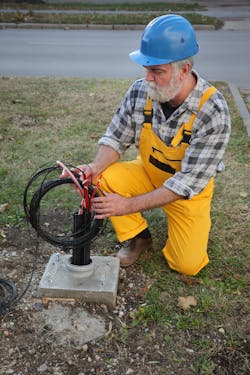Bridging the digital divide faces a workforce challenge

Market forces and once-in-a-lifetime funding opportunities are driving the deployment of fiber broadband nationwide. In early 2020, the Federal Communications Commission’s Rural Digital Opportunity Fund (RDOF) allocated $20.4 billion in funding over ten years to support developing broadband networks in rural communities. Then on November 15, 2021, the Biden Administration signed the significant $65 billion bipartisan infrastructure bill into law, including the Broadband Equity Access and Deployment (BEAD) program that sets aside more than $42 billion for constructing these networks with a priority on covering unserved and underserved locations.
Despite demand and funding, the industry faces a lack of skilled labor that threatens to slow rollouts and adversely impact fiber network performance and reliability. While states can use BEAD funds for training and workforce development, more than half of available funds will go to cover make-ready costs—surveys, planning, permits, approvals, utility pole upgrades and expansion, and other processes necessary to prepare for deployment. With the bulk of the remaining monies for deployment and promoting user adoption, very little (if any) will be allocated for upfront training, creating a cyclical problem of needing trained, skilled workers to later fix improperly installed networks. But there is more to the challenge that demands attention.
A twofold conundrum
The longstanding stigma on trade careers and the growing number of those retiring versus those entering the workforce has much to do with the lack of a skilled workforce needed to bring broadband to the more than 60 million homes in rural communities over the next five years. However, another obstacle is that unlike most commercial premise LAN projects where it’s common for specifications to require a BICSI Registered Communication Distribution Designer® (RCDD®) and BICSI-certified installers and technicians, outside plant broadband fiber projects rarely require any training or credentials.
Most current fiber technician job postings—especially those from Tier-3 last-mile providers and new small entrants—require applicants to have little more than a valid driver’s license and the ability to travel, work on ladders and in confined spaces, and distinguish colors. Yet responsibilities include splicing loose tube and ribbon fiber, constructing fiber enclosures, dressing fiber cables, and OTDR testing. Some postings state that training is provided on the job, but that doesn’t necessarily mean quality training.
“It’s an interesting landscape. Companies are jumping at the opportunity and funds to deploy fiber, but there is a shortage of fiber technicians everywhere. Companies are desperate to get workers into the field,” says Sean Kelly, technical director for Light Brigade. “That means they end up putting out button pushers who don’t know why they’re doing what they’re doing, increasing the potential for poor splices, fiber that isn’t routed properly or enclosures that aren’t sealed—all of which can compromise long-term reliability and performance.”
While lacking skilled workers is not U.S.-centric, Kelly points out that other regions are better at requiring qualifications. In the UK, anyone in the construction industry must hold a job card, which provides proof of the required training. There are a variety of job card levels, and even the very lowest entry-level “Labourer” status indicates completed coursework in construction health and safety awareness. Only those who have achieved construction-related National Vocational Qualification (NVQ) level 2 or an apprenticeship can obtain a skilled worker card.
“Ideally, we need to come together and implement some level of required competency and standardization similar to the UK job cards. There are plenty of quality education providers—Light Brigade, BICSI, FOA, KITCO Fiber Optics, community colleges, and others—who can provide that training,” says Kelly.
One option is for companies to employ ETA® International’s standard suite of vendor-neutral ISO 17024-accredited fiber certifications that include Fiber Optics Installer ( FOI), Fiber Optics Technician (FOT), and FOT – Outside Plant (OSP). Training providers such as Light Brigade, KITCO, the US Army, and others undergo an extensive vetting process to provide approved education toward ETA certification.
“There has been an increase in earned FOI and FOT-OSP certifications over the past couple of years,” says David Weaver, research and development coordinator for ETA International. “Tier 1 providers such as AT&T and Verizon are currently utilizing our standard suite of fiber certifications, and we’ve seen an increase in blending these certifications as more overlap happens during the installation and maintenance of these networks.”
But requiring training for all US broadband deployments is easier said than done. “It would be extremely difficult to backpedal and now require training when fiber is already being deployed,” says Shirley Bloomfield, CEO of NTCA (The Rural Broadband Association). “And we’re now deep into the deployment where workers are coming on site with everyone working around the clock, which leaves little time for training.”
Low wages are another major obstacle—especially in rural regions. A quick search on Talent.com or Indeed.com clearly shows the disparity with the average hourly wage for fiber splicing at around $90 per hour in New York City versus just $17 to $24 per hour in Arkansas.
“Wage regulation may be the answer. However, in some currently regulated wage programs, techs are not being paid a competitive rate if they touch anything other than voltage. In rural areas, many aren’t making much more per hour than they can make at Walmart, where they don’t have to deal with the unglamorous side of working outdoors in all sorts of weather,” says Kelly. “So where we need fiber the most, we’re not paying enough, and experienced techs are unwilling to work there.
Bloomfield agrees. “The bodies are tough to find, and they’re tough to keep. If you train a smart young person, they often move to areas where they can obtain much higher wages,” she says. “Rural broadband companies need to figure out how they can stand out if everybody is competing for workers, and we need to make the job more of a career.”
Kelly also points out that some are getting paid by the fusion splice or “burn.” “This can lead to technicians doing as many splices as possible in the shortest amount of time, further lowering the quality of work,” he says.
The value of apprenticeship
With non-college-bound youth overwhelmingly unable to pay for training and unwilling to rack up student debt, filling the pipeline of qualified workers and reducing turnover requires a new approach. Kelly and Bloomfield point to the need for paid apprenticeships like those historically associated with electricians and plumbers.
“There are training programs available, but companies can’t always afford to take people out of the field to get them trained,” says Kelly. “We cannot expect young people to pay for their training before getting the job. We need to establish new ways to modularize the training and better educate company owners to recognize that training employees can help guarantee the quality of their work.”
The value of apprenticeship is not going unnoticed. In June 2022, the Biden Administration kicked off the Talent Pipeline Challenge as a nationwide call to action for employers, unions, training providers, states, local governments, tribes, and other stakeholders to make tangible commitments for equitable workforce development with a keen focus on apprenticeship programs. Efforts are underway.
Late last year, the Communications Workers of America (CWA) announced a statewide expansion of fiber technician apprenticeships across California. In March 2023, the Vermont Community Broadband Board and Vermont Department of Labor partnered with the state technical college to launch a new Broadband Installer Apprenticeship Program. The Pennsylvania Department of Labor & Industry announced $800,000 to support broadband expansion through registered apprenticeship programs in April. Similar initiatives are happening in several other states. The US Department of Labor also recently announced another $5 million to fund up to 14 grants to attract and support women accessing registered apprenticeship programs.
According to Bloomfield, the NTCA is stepping up multi-tier apprenticeship, training, and education partnerships. CWA now makes its apprenticeship programs accessible to NTCA member companies with CWA workforces. Wisconsin’s Northwood Technical Collage provides NTCA member companies online access to its Broadband Academy courses and a “Digital Badging” program in which students may enroll on an individual course-by-course basis or complete the full program. NTCA and Northwood also plan to create a standard template for apprenticeship-like training to guide NTCA member companies’ supervised work experience and mentoring to students who concurrently enroll in or have completed Northwood Tech coursework.
Too late is too little
While apprenticeships help address the problem, Kelly points out that young people still need the desire to enter into these programs. “Many of those retiring came into the industry behind a family member, but they haven’t successfully brought in the next generation,” he says. “It all comes back to attraction. If we can gain youth’s interest in this trade, they will have the desire to learn.”
NTCA’s Bloomfield concurs. “Jobs in this space are cool, but we need to grab attention at an earlier age and tie their love of gaming and being online to building these networks,” she says. To that end, NTCA is working with member companies to go deeper with recruiting efforts—attending job fairs, sponsoring local high school and e-sport teams, and bringing higher schoolers in as interns. They are also partnering with the National Rural Education Association (NREA) to identify existing and new curricula that correlate to broadband industry needs and combine that coursework with internship opportunities, ride-alongs, and job fairs to raise awareness of careers in the broadband industry.
“We’re even working with the NREA to develop a K-12 guide to start talking to students at the elementary level about these careers,” says Bloomfield. “I remain hopeful, but time is of the essence.”
About the Author

Betsy Conroy
Betsy Conroy has spent the past three decades writing quality technical content and leveraging that content to launch impactful integrated marketing campaigns. She started her career as a technical and promotional writer for medical, security, and environmental corporations. In early 2000, she became an independent freelance writer, editor, and content consultant, focusing primarily on B2B manufacturers and associations in the electrical, networking, and telecommunications industries. Betsy frequently publishes content in a variety of industry publications.